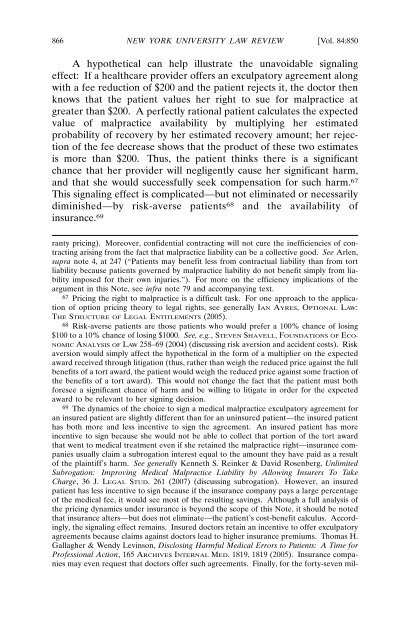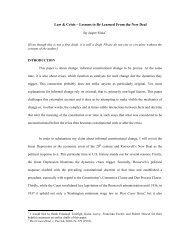In Search of an Enforceable Medical Malpractice Exculpatory
In Search of an Enforceable Medical Malpractice Exculpatory
In Search of an Enforceable Medical Malpractice Exculpatory
You also want an ePaper? Increase the reach of your titles
YUMPU automatically turns print PDFs into web optimized ePapers that Google loves.
866 NEW YORK UNIVERSITY LAW REVIEW [Vol. 84:850<br />
A hypothetical c<strong>an</strong> help illustrate the unavoidable signaling<br />
effect: If a healthcare provider <strong>of</strong>fers <strong>an</strong> exculpatory agreement along<br />
with a fee reduction <strong>of</strong> $200 <strong>an</strong>d the patient rejects it, the doctor then<br />
knows that the patient values her right to sue for malpractice at<br />
greater th<strong>an</strong> $200. A perfectly rational patient calculates the expected<br />
value <strong>of</strong> malpractice availability by multiplying her estimated<br />
probability <strong>of</strong> recovery by her estimated recovery amount; her rejection<br />
<strong>of</strong> the fee decrease shows that the product <strong>of</strong> these two estimates<br />
is more th<strong>an</strong> $200. Thus, the patient thinks there is a signific<strong>an</strong>t<br />
ch<strong>an</strong>ce that her provider will negligently cause her signific<strong>an</strong>t harm,<br />
<strong>an</strong>d that she would successfully seek compensation for such harm. 67<br />
This signaling effect is complicated—but not eliminated or necessarily<br />
diminished—by risk-averse patients 68 <strong>an</strong>d the availability <strong>of</strong><br />
insur<strong>an</strong>ce. 69<br />
r<strong>an</strong>ty pricing). Moreover, confidential contracting will not cure the inefficiencies <strong>of</strong> contracting<br />
arising from the fact that malpractice liability c<strong>an</strong> be a collective good. See Arlen,<br />
supra note 4, at 247 (“Patients may benefit less from contractual liability th<strong>an</strong> from tort<br />
liability because patients governed by malpractice liability do not benefit simply from liability<br />
imposed for their own injuries.”). For more on the efficiency implications <strong>of</strong> the<br />
argument in this Note, see infra note 79 <strong>an</strong>d accomp<strong>an</strong>ying text.<br />
67 Pricing the right to malpractice is a difficult task. For one approach to the application<br />
<strong>of</strong> option pricing theory to legal rights, see generally IAN AYRES, OPTIONAL LAW:<br />
THE STRUCTURE OF LEGAL ENTITLEMENTS (2005).<br />
68 Risk-averse patients are those patients who would prefer a 100% ch<strong>an</strong>ce <strong>of</strong> losing<br />
$100 to a 10% ch<strong>an</strong>ce <strong>of</strong> losing $1000. See, e.g., STEVEN SHAVELL, FOUNDATIONS OF ECO-<br />
NOMIC ANALYSIS OF LAW 258–69 (2004) (discussing risk aversion <strong>an</strong>d accident costs). Risk<br />
aversion would simply affect the hypothetical in the form <strong>of</strong> a multiplier on the expected<br />
award received through litigation (thus, rather th<strong>an</strong> weigh the reduced price against the full<br />
benefits <strong>of</strong> a tort award, the patient would weigh the reduced price against some fraction <strong>of</strong><br />
the benefits <strong>of</strong> a tort award). This would not ch<strong>an</strong>ge the fact that the patient must both<br />
foresee a signific<strong>an</strong>t ch<strong>an</strong>ce <strong>of</strong> harm <strong>an</strong>d be willing to litigate in order for the expected<br />
award to be relev<strong>an</strong>t to her signing decision.<br />
69 The dynamics <strong>of</strong> the choice to sign a medical malpractice exculpatory agreement for<br />
<strong>an</strong> insured patient are slightly different th<strong>an</strong> for <strong>an</strong> uninsured patient—the insured patient<br />
has both more <strong>an</strong>d less incentive to sign the agreement. An insured patient has more<br />
incentive to sign because she would not be able to collect that portion <strong>of</strong> the tort award<br />
that went to medical treatment even if she retained the malpractice right—insur<strong>an</strong>ce comp<strong>an</strong>ies<br />
usually claim a subrogation interest equal to the amount they have paid as a result<br />
<strong>of</strong> the plaintiff’s harm. See generally Kenneth S. Reinker & David Rosenberg, Unlimited<br />
Subrogation: Improving <strong>Medical</strong> <strong>Malpractice</strong> Liability by Allowing <strong>In</strong>surers To Take<br />
Charge, 36 J. LEGAL STUD. 261 (2007) (discussing subrogation). However, <strong>an</strong> insured<br />
patient has less incentive to sign because if the insur<strong>an</strong>ce comp<strong>an</strong>y pays a large percentage<br />
<strong>of</strong> the medical fee, it would see most <strong>of</strong> the resulting savings. Although a full <strong>an</strong>alysis <strong>of</strong><br />
the pricing dynamics under insur<strong>an</strong>ce is beyond the scope <strong>of</strong> this Note, it should be noted<br />
that insur<strong>an</strong>ce alters—but does not eliminate—the patient’s cost-benefit calculus. Accordingly,<br />
the signaling effect remains. <strong>In</strong>sured doctors retain <strong>an</strong> incentive to <strong>of</strong>fer exculpatory<br />
agreements because claims against doctors lead to higher insur<strong>an</strong>ce premiums. Thomas H.<br />
Gallagher & Wendy Levinson, Disclosing Harmful <strong>Medical</strong> Errors to Patients: A Time for<br />
Pr<strong>of</strong>essional Action, 165 ARCHIVES INTERNAL MED. 1819, 1819 (2005). <strong>In</strong>sur<strong>an</strong>ce comp<strong>an</strong>ies<br />
may even request that doctors <strong>of</strong>fer such agreements. Finally, for the forty-seven mil-
















